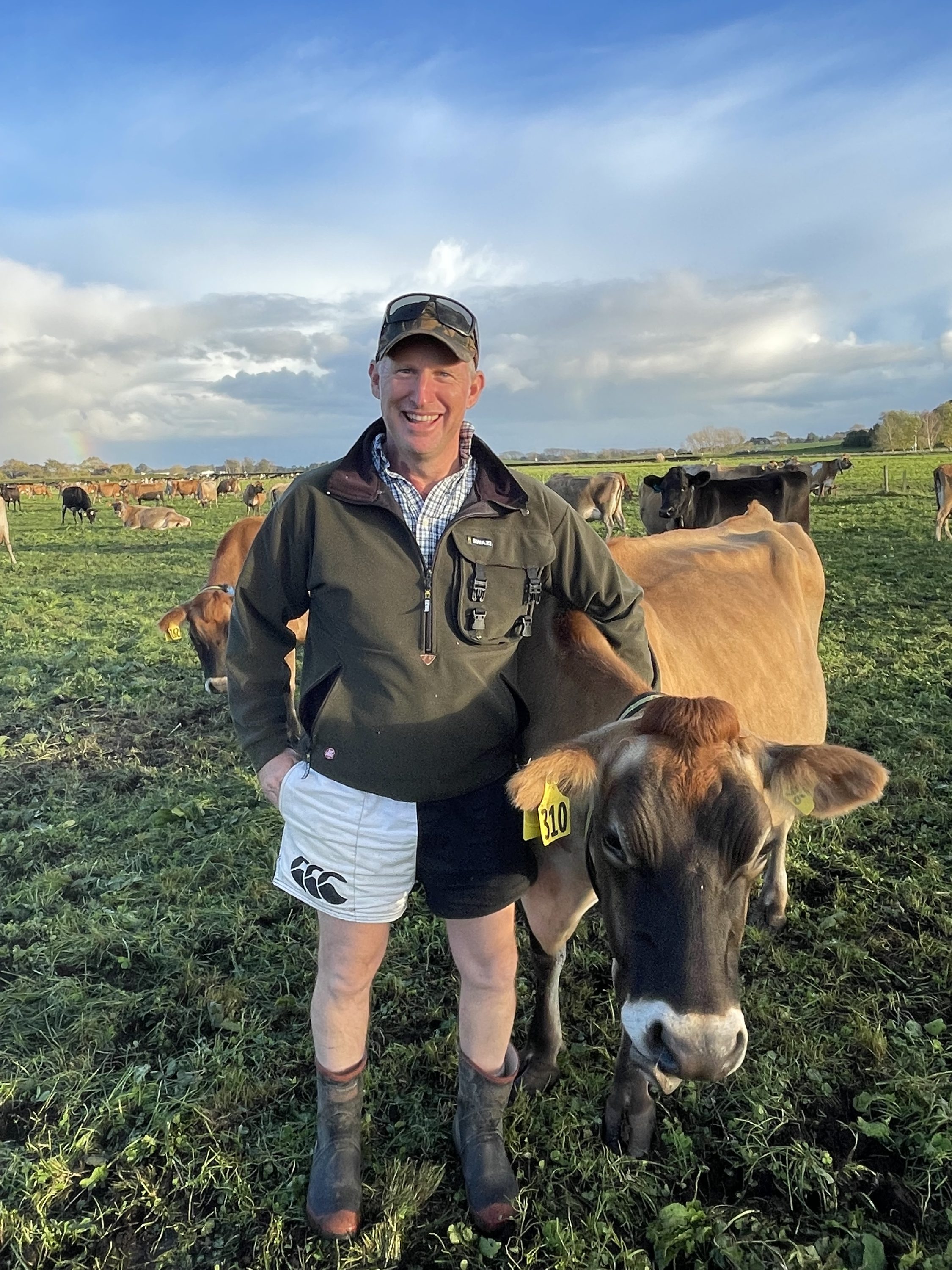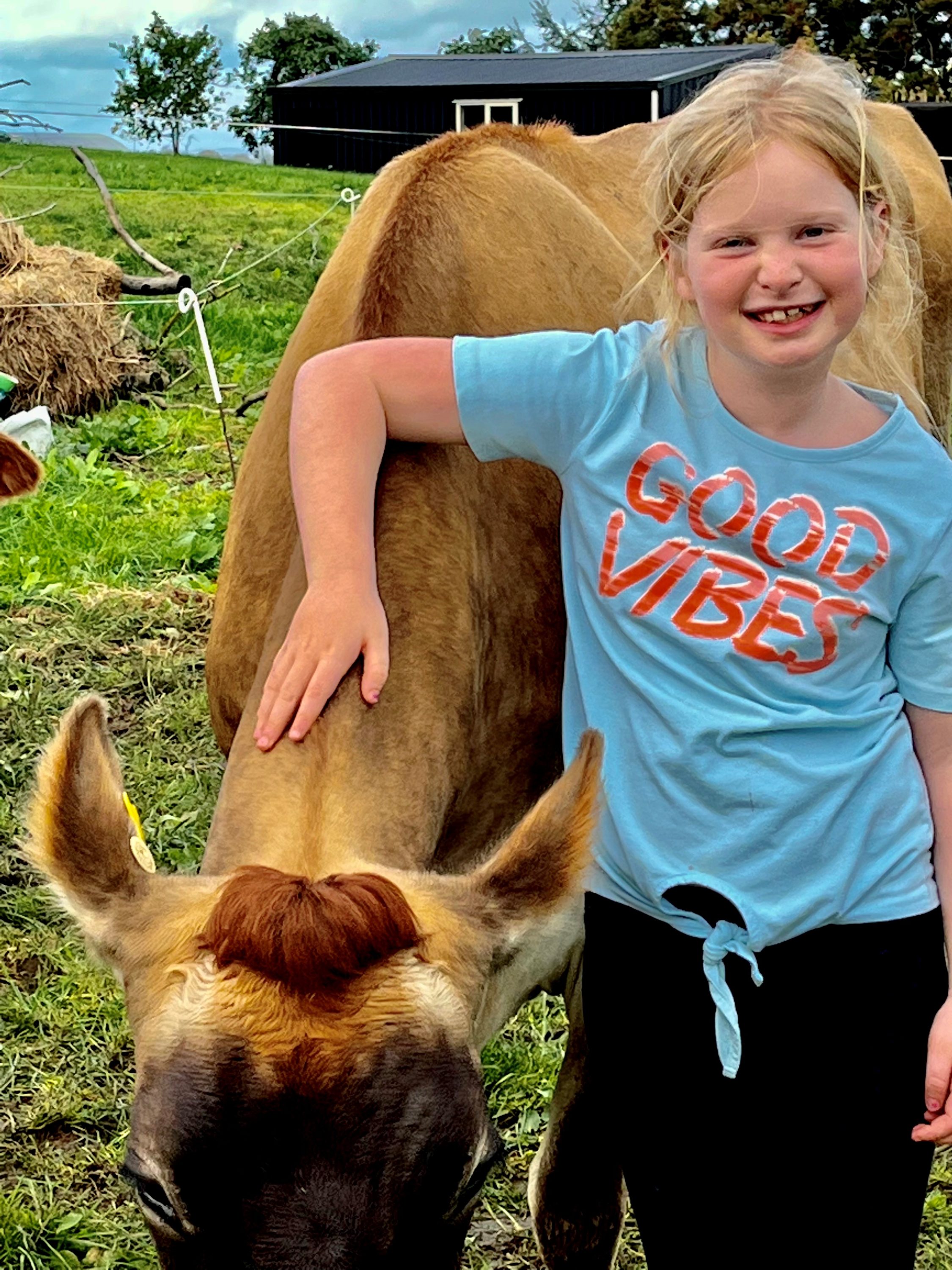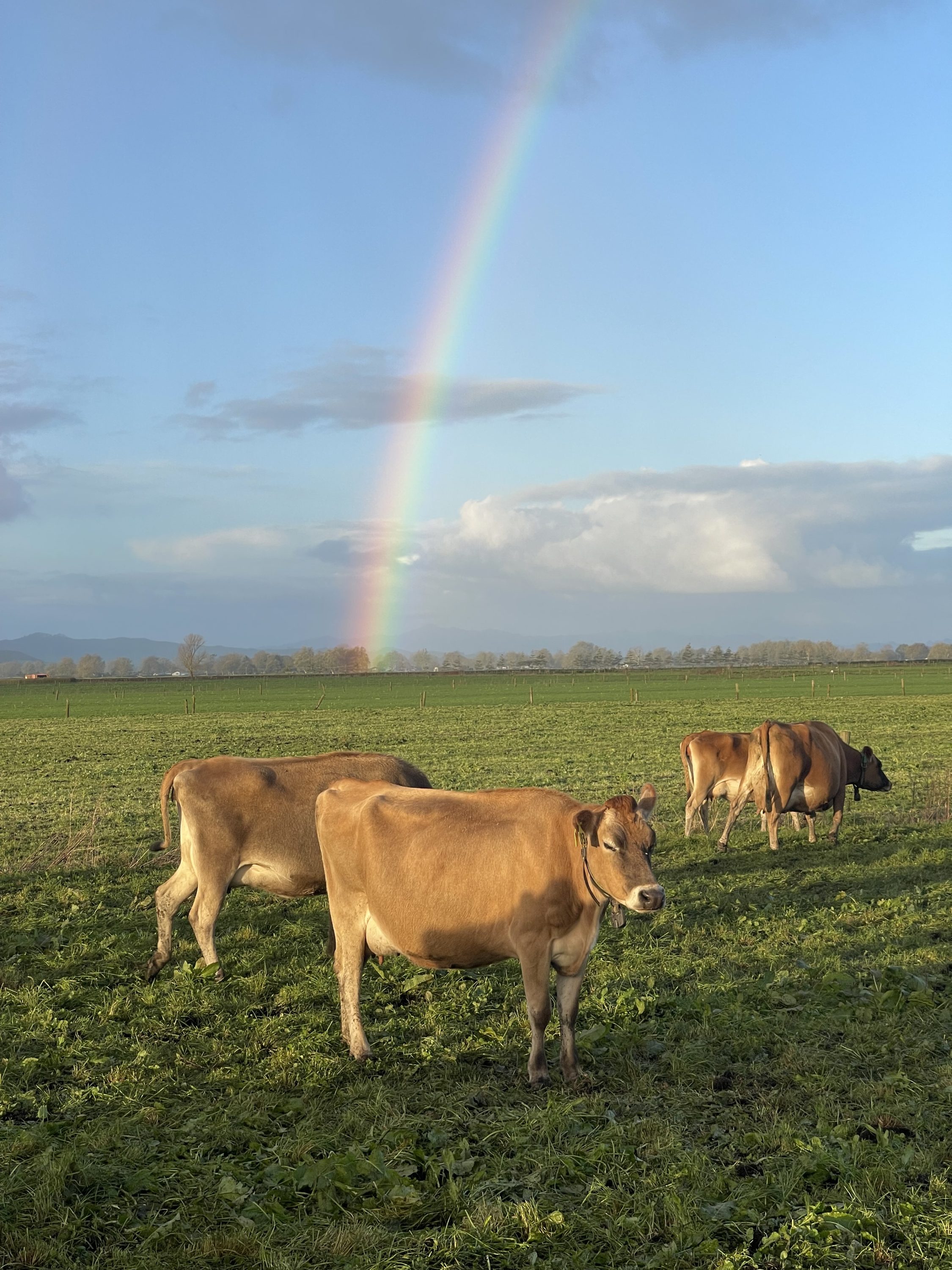Maharee Jerseys
Brendan & Stacey White of Maharee Jerseys, Taupiri are making their mark. They are not strangers to the Jersey breed, with strong family connections on Brendan’s side right back to his grandfather. His Jersey herd was bred to black & white on obtaining a winter milk contract (based on extra litres). The herd was sold to a sharemilker on the then-family farm at Te Kauwhata and on his retirement in 1993 the farm was taken over by Brendan’s parents who really wanted to return to Jersey. They purchased the Barryn herd from Robin & Bruce Barker and the circle was complete.
Brendan started on the family farm in 1996, and in the next few years bought two lines from the Miers family Miersvale herd (Waihi) and Athol Dempsey’s Threetier herd from Murupara. These were farmed with the Barryn cows to create a nice herd.
The implementation of Breeding Worth saw demand rise for smaller Jerseys, but this ended up putting many people off as the cows were seen as small & weak and not the big, strong cow that genetically they can be. Brendan wasn’t keen to follow this trend, and so moved away from BW as a focus. With no intention of selling his herd he was free to breed the type of cow he liked. However, he then found himself getting frustrated when trying to sell his surplus cows, everyone was chasing BW and PW and weren’t prepared to even look at his cows. So the business side in him came out and by 2013 he started to use some Holstein Friesian bulls to meet the market. While some of the first cross cows were fantastic, he found that the temperament of the herd deteriorated, and his production didn’t increase.
Through these years the makeup of the herd changed to a 60/40 crossbred/Jersey ratio. In 2018 Brendan & Stacey moved to the current 120 ha farm at Taupiri, and the Te Kauwhata farm is now a residential development. He has retained a 130 ha runoff in Te Kauwhata, about a 20 minute drive from the Taupiri farm. By 2020 Brendan was hankering for a more predominantly Jersey herd again. Analyzing their herd’s production, he found that the crossbreeds and Friesians had done only 18 kg more milksolids on average than the Jerseys. Considering the other factors in maintaining the larger crossbred and Friesian cows, the decision was easy – a return to the Jerseys he loves.
The herd hadn’t been registered for a while, but Stacey spotted a heifer she liked for sale on Facebook. It was Glen Leith heifer bred by Bruce & Margaret Sim. Brendan wasn’t successful in purchasing that heifer, but when the Sims came back & offered a different heifer Brendan jumped at the opportunity. He has
since regularly purchased Glen Leith stock and keeps in regular contact with Bruce & Margaret. In turn, that renewed the interest in maintaining the pedigrees and the herd is now registered. The herd BW is 326 with a PW of 367.
Another relationship formed has been with Lyna & Luke Beehre after Brendan & Stacey purchased 200 of the A2A2 cows from the Okura herd when it was sold and followed up with another 50 heifers this year. As part of his plan to move the herd more to Jersey, Brendan had to sell 200 of the crossbreds. Even though he loves the Jerseys it was still hard to part with any stock, Brendan says he’s a great buyer but a terrible seller – he just wants to keep everything. Maharee Farms supply Synlait with their A2A2 milk. LIC and CRV have both contracted numerous cows between them, and Brendan had seven bull calves purchased this year. Four went to CRV and three to LIC including two into the Jersey Future team – Maharee Bas Kaiden and Maharee Laz Forrest. Brendan & Stacey enjoyed attending their first Premier Sires Breeders dinner in 2023.

When visited, Brendan had dropped from twice a day down to once-a-day milkings in mid-March, and was expecting to dry off mid-May. Official production has been affected this season by an abnormal herd test, but Brendan feels that they were down anyway. He believed the hype and put a few more cows on with the move to Jersey but discovered that a good Jersey will eat just as much as the larger breeds. They didn’t have a lot of grass at the beginning of the season, and while they grew plenty through the summer they were badly affected by spring. With little pasture available they started feeding quite a high-starch meal in the shed and inadvertently put the cows into acidosis. Over two weeks the cows lost on average 35 kg, and Brendan comments that it was probably the most stressful time in his farming career. Down 20% on production in spring, they clawed back through the season to only 6-7% down.
Record production on the farm at the factory is 195,000 kg MS in both the 2020/21 and 2021/22 seasons. Brendan expects they will reach 185,000 kg MS this season. The 2021/22 season was through one of the worst droughts that Brendan has experienced, but the herd still did the production by feeding a little more and filling the gaps with supplements.
Before Brendan purchased this block, the previous record was 161,000 kg MS from a really good operator and Brendan increased that to 168,000 in the first year, in the 170’s the second and then the two record years at 195,000. Having pushed for production with feed and management, he is now happy to reduce the stocking rate and get back to making more grass silage.
Turnips are usually grown as a supplement, and this season they tried fodder beet for the first time. Although fodder beet as a crop doesn’t like wet feet, that’s exactly what happened this summer. While the yield wasn’t as good as it could have been, the cows transitioned really well to the new feed, just loved it and didn’t leave anything behind. Maize is grown at the run off, and grass silage brought back from there too. Making as much grass silage as they can on farm they also feed 2 kg per day of meal for most of the season through in-shed feeding. Last season that doubled through the spring due to the lack of grass.
He calved down 420 cows this season from 10 July compared to his usual 400. But for the coming season he intends to drop below that. Rather than buy the extra production with supplementary feed, he would rather be the farm that grows really quality good grass for a lot less than having to buy feed in and move back to a more simple style of farming. Partially behind this decision is the fact that the breeding side of the herd is now a lot more intense, with numerous contracts and lots of embryo work (about 100 embryos over the last 2-3 years over both Jersey & crossbred with 40 different sires). So, there are plenty of beef recipients up at the runoff including Angus and Speckle Park.
With so many contracts and embryo calves, there are a lot of calves to be reared. With the dairy grazers now gone from the runoff, Brendan intends to rear more surplus bull calves for sale. He currently has approx. 55 yearling bulls at the runoff that he will sell in the spring. Only a few bulls are now bobbied and all AB heifer calves are either reared or sold. With 420 cows calved and 210 calves reared, a new calf setup and new systems in place this season has been a godsend, with no sick calves for the first time. He has been genotyping his calves for the past two years, and the whole herd is DNA parentage verified.
The young stock go up to the runoff and come back as in-calf heifers, while the cows are wintered on the
farm. Traditionally they have also taken in 100-120 dairy grazers on the runoff each year. Now though, he is rearing more surplus stock himself for sale. Traditionally, Brendan has experienced metabolic issues through the spring period. This season they fed the cows a transition mix and it made a huge difference with the cows calving easily with good colostrum and producing good, strong calves. In fact, they changed so much of the process around transition and calf-rearing with such great results that they are not sure what really made the difference. Brendan expects that it was a combination of all the factors, so he won’t change anything!
Collars went on the cows in June 2022 and Brendan is finding all the extra information on the cows quite intense. Talking to other farmers he is relieved to hear that it takes most of them a good season to get their heads around the data available and use it effectively. Brendan & Stacey have had contract milkers on the farm for the last five seasons. The contract milkers have now bought a herd and are going sharemilking. Their worker is taking the step up and will now manage the farm.

Brendan is really happy with the makeup of his herd now. With the purchase of the Okura stock and another 50 cows from Glen Leith, alongside the animals of his own breeding that have been retained, Brendan thinks he has put together a herd that is going to be outstanding moving forward.
The start of mating is 10 October, with the heifers also AB mated a little earlier for a few days. The cows will get five weeks of AB mating then they will finish off with short gestation beef. This year is the first that he has not used any bulls as a trial, and next year he will return to his normal process of five weeks of AB, three weeks with the bull and the final two weeks of SGL mating. Not a user of Premier Sires, Brendan nominates each bull used on the farm. He enjoys picking his own team of bulls, and there is always something that he is looking to breed for. More open to trying overseas genetics now, Brendan used a little Danish semen last year.
When selecting bulls, Brendan is chasing good udders and capacity, because when you get capacity it flows onto good dairy conformation. He likes a wide, sloping rump. If a rump starts low it evens out and becomes ‘a nice sort of flat’ as the cow matures. He always considers the management traits on bulls “I want to use a bull that we’re going to enjoy milking, and it’s not going to give people a hard time in the shed.” He also looks for a good, strong maternal line on the pedigrees. Brendan is intending to classify the herd this season. “If I can get a 445 kg cow doing more than 500 solids, that’s my kind of cow.”
The Maharee herd took part in the DairyNZ AEL 3.5 genomic project this season. This meant that the herd was genomically tested, parentage verified, weighed and Body Condition Scored with the data all going towards the NZAEL 3.5 dataset. Brendan collects much of this data anyway, but he saw this project as a vital industry good exercise so was happy to play his part.
Brendan & Stacey met in 2008 on a tour bus in Europe. Just friends at first, on their return to New Zealand the relationship developed during another group travel experience in Africa. Stacey works off-farm as a teacher at the local Orini School specializing in Complex Education Needs and Neurodiversity and is also completing her Masters Degree. Brendan & Stacey have one daughter, Reese (9), and Brendan has two grown sons from a previous relationship.

Brendan spends time with the herd every day. Feeding out, moving breaks, just moving through them and giving out scratches. He thinks if everyone could do that it would help our mental health immensely! Self-described as cow mad you’ll more likely find him reading a bull or sale catalogue than watching TV in the evening, or maybe a fishing magazine.
The family have a beach house and a boat at Whitianga, and one of Brendan’s goals is to get a bit more time over there with the family. Daughter Reese is taking quite an interest in the farm, knows all the bulls they have used, is really following the breeding and has had some success with the calf club calf.
Brendan’s personality sees him want to do everything as well as he possibly can. Where does he want to be in 10 years time? “I want to do what I’m doing now, I want to breed good cows, I want to catch big fish, I want to shoot big deer.”
Why does Brendan love his Jerseys so much? “Just the breed for me, temperament, profitability, I just think they’re just a great cow and a seriously underrated breed.”
